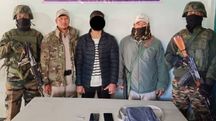B'nei Menashe caught in dual conflict; Manipur's forgotten crisis mirrors Israel's turmoil
In Manipur, three B'nei Menashe communities were obliterated along with their synagogues. Concurrently, in Israel, the B'nei Menashe faced direct attacks from Hamas in Sderot, leading to their evacuation.
 B'nei Menashe caught in dual conflict; Manipur's forgotten crisis mirrors Israel's turmoil
B'nei Menashe caught in dual conflict; Manipur's forgotten crisis mirrors Israel's turmoilOver a year has passed since the pogrom on May 3, 2023, since the ethnic clash took place between two communities in Manipur. This conflict parallels the violence on October 7, 2023, when Hamas terrorists infiltrated Israel, killing 1,200. Both conflicts remain unresolved and in both, the B'nei Menashe community has suffered significantly.
In Manipur, three B'nei Menashe communities were obliterated along with their synagogues. Concurrently, in Israel, the B'nei Menashe faced direct attacks from Hamas in Sderot, leading to their evacuation. Both situations are marked by the use of false narratives to deny people their connection to their homes and by perpetrators portraying themselves as victims.
Despite the ongoing war in Israel capturing international headlines, the Manipur conflict has faded from mainstream media attention.
Accusations against the Kuki-Zo, such as being illegal immigrants and narco-terrorists, have been used to dehumanize the community. Former police officer Brinda Thounoujam, has publicly accused Manipur's Chief Minister, N. Biren Singh, of being responsible for the current turmoil, even labeling him a drug lord.
Before the conflict, Imphal was home to many Kuki-Zo professionals.
Armed miscreants systematically targeted Kuki-Zo homes in Imphal sparing Naga and Meitei homes. This organized violence suggests years of meticulous planning rather than spontaneous mob action.
The conflict's origins are debated. Some Meiteis cite a protest in Lamka against their demand for Scheduled Tribe status, while the Kukis point to the burning of a gate commemorating the Anglo-Kuki war. The truth remains elusive. Meanwhile, crude oil discoveries and strategic geopolitical interests, such as the town of Moreh on the Myanmarese border add complexity to the situation.
The B'nei Menashe, part of the greater Kuki-Zo ethnic group, have shared in the suffering. Displaced from Imphal, Kangchup, and Sajal, they found temporary refuge in relief camps and with relatives. Degel Menashe, a relief organization, has been instrumental in providing essential supplies and shelter. A new settlement, Kibbutz Maoz Tzur, has been established in Lamka to help them rebuild their lives.
Calls for the annihilation of the Kuki-Zo have been openly made by leaders like Pramot Singh of Meetei Leepun. The statistics are grim: over 220 dead out of which 180 from Kuki-Zos, 60,000 displaced out of which over 40,000 are Kukis, 200 villages and 7,000 houses destroyed and numerous churches and synagogues razed.
The B'nei Menashe's plight is intertwined with the broader Kuki-Zo struggle. Maoz Tzur offers a beacon of hope, providing a sanctuary where they can rebuild their lives free from persecution. The project includes plans for sustainable living through farming, animal husbandry and education. The ultimate goal is to create a secure and self-sufficient community, preserving their heritage and preparing for a future in Israel.
As conflicts rage on both fronts, the B'nei Menashe continue to navigate these turbulent times, seeking stability and safety amidst chaos.
Copyright©2025 Living Media India Limited. For reprint rights: Syndications Today









